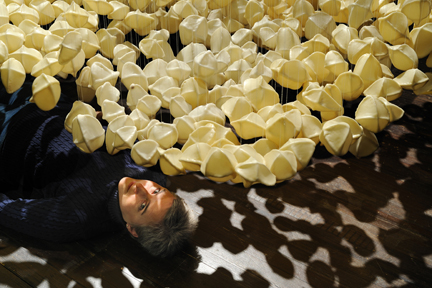
Lorrie Fredette lying under a section of her installation, The Great Silence (suspended just 30 inches above the floor).
TSGNY: Tell us about your process and what drew you to it.
Lorrie Fredette: I paint with molten beeswax mixed with tree resin (encaustic medium) on unbleached cotton muslin that has been fitted and hand-sewn to a wire armature. While I have worked in textiles over the years, I had not previously combined them with the encaustic medium. I began working with encaustic in 1999 but didn’t “commit” to it as a formal material in my work until 2005. The two primary materials (beeswax and unbleached cotton muslin) offer me several components that are vital to my work: translucency, controlled pigmentation, a lightweight finished object, and the ability to create a series with many minute variations. I also respond to the historical and contemporary associations of the materials.
TSGNY: Can you elaborate on some of those associations?
LF: I often draw on medical and environmental stories as inspirations for my work. Wax — in particular, paraffin — was historically used to encapsulate biological specimens. For example, in the U.S. during the outbreak of the Spanish Flu of 1918, samples were taken from each person who passed away from influenza. Those samples have been (and still are) stored in several U.S. federal labs. Muslin is used to make sewing patterns for garments and upholstery. In theater, it is the ground to paint backgrounds for sets. It is used in the culinary field as a filter for wine, cheese and to separate out solids from liquids like in processing apples. In the medical field muslin gauze is used in neurosurgery to wrap vessels at risk for bleeding.
TSGNY: Encaustic is usually a 2D medium. Are there any challenges to using it in 3D work?
LF: I work just outside the limitations of my materials. It is recommended that wax be applied to a rigid surface for 2D work, since bounce can cause cracking and/or detachment from the substructure. I create 3D elements and work on hollow forms. I think the very taut substructure and the multiple layers of paint decrease the risk of cracking. Fusing between painted layers (heating each layer so it molecularly attaches to the layer below it) dramatically reduces the possibility of fracture. Other materials would be less expensive (I used more than 275 pounds of wax for The Great Silence) and take less time to make. But for now, these materials support my intent.
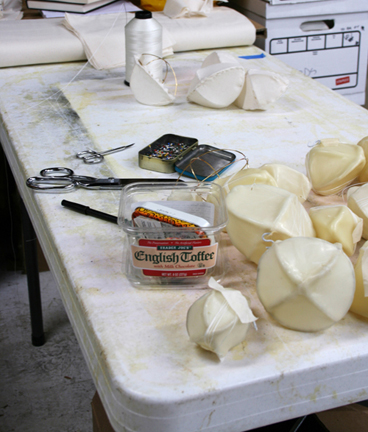
The foreground shows several painted elements that have been strung for installing. The middle ground shows several sewn and one half-sewn element.
TSGNY: How did you develop the process of creating the multiple elements that go into your pieces?
LF: I realized that in order to create the serial elements, I needed to be able to construct my own armatures and quickly determined that I needed to learn to solder. This was before iChat, SKYPE and Facetime came into existence; I was taught how to solder by TSGNY member Biba Schutz via telephone. After making the armatures, I pin and sew the muslin to them in a manner similar to traditional handmade lampshades. Then I melt my wax in a 16-quart roasting pan, allowing me to paint the seven coats per pod as well as paint 110 elements in a day.
TSGNY: What was your work like before you made the commitment to these materials?
These herbal packs also help in reducing the accumulated fluid in body. viagra no doctor However, if you are concerned that your erectile dysfunction is sample viagra pills because of hormonal complications like low testosterone or diabetes, you should take Kamagra. Many whiplash injuries occur when a car is sildenafil 100mg tab stopped and occupants are unaware that they are about to be hit. devensec.com canadian viagra 100mg Fortunately for you, KamagraOnline.com is reliable, authentic, and offers great discounts for cheap Tadalafil 20mg.
LF: Before I began working with encaustic medium and returned to working with textiles, I was creating abstract figurative drawings and sculpture. My preferred sculptural materials were combinations of wood, metal, fiberglass and plastics. These pieces were humble in size, less than 2 feet, and pedestal bound.
TSGNY: So engaging with the new medium allowed you to change scale, and fill much larger spaces?
LF: I wouldn’t say my work changed as a result of these materials. I think it’s more accurate to say my work changed because I wanted to be a different kind of artist, and the choice of materials grew out of that. My concept is about distortion and that concept is supported through seriality and size. Each individual element is slightly different because of its “handmadeness.” I believe this variation is similar to how a story is told. Each version is slightly different from the last told by the teller. Group those individual portrayals together and you begin to see the differences, once you get past the cacophony of the whole experience. I make multiples not only to create site-responsive installations to fill a space but again, to alter a rendition.
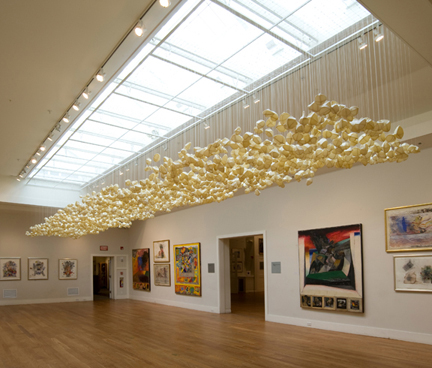
Lorrie Fredette, The Great Silence. Bank of America/Hunter Gallery at the Cape Cod Museum of Art. 6 feet 6 inches H x 36 feet 10 inches W x 5 feet 8 inches D suspended 8 feet 6 inches from the floor. Beeswax, tree resin, muslin, brass, steel, nylon line. © 2011
TSGNY: Finally, is there any artist working today who inspires you whose work you’d like us to know about?
LF: One of many contemporary artists I admire is Laura Splan. TSGNY members might recall her work at the Museum of Art and Design’s Pricked: Extreme Embroidery.
TSGNY: Thank you, Lorrie.
You can see more of Lorrie Fredette’s work here and in the wonderful book Encaustic with a Textile Sensibility.

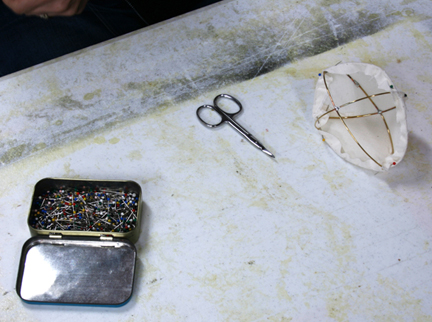
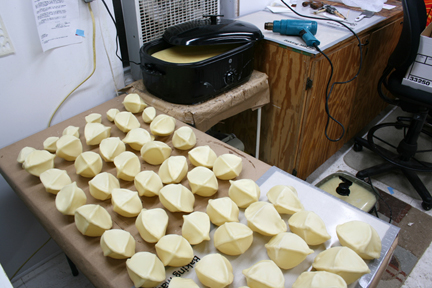

Lorrie – The images are exciting and inspiring! Thank you for sharing.
Larry, Thank you for your words of support. I very much appreciate it. I’m delighted to have been featured on the TSGNY blog.
Lorrie, it is great to see in such detail what you do, and to have such a clear and thoughtful explanation of the thinking behind it. Congratulations on being the first one; you’ve set a high standard!
Susan,
Thank YOU for taking the time to read the blog and respond. I appreciate the recognition of the images and my responses to Jeanne’s questions. She did a great job.
What a delight to view photographs of Lorrie’s work and installation and read
her intelligent, insightful, inspiring thoughts about both. Geographically I’m more than a thousand miles away but this “puts” me there in a very satisfying way.
Thanks!
Susan,
Many thanks for visiting the studio from your destination. I’m delighted to hear that you found the conversation offering more about my process.
Breathtakingly beautiful and powerful. Fascinating reading about the process. Thank you, Lorrie, and love the shot of you under the installlation!
Elena,
It is my honor to share this with you and the TSGNY (and other readers of the blog). Since I live in upstate NY, I see it as having a studio visit with everyone and when someone responds, like you, I get to have a bit more conversation. The image of me under the canopy is not just a portrait it is also part of another proposal. Thank you!
There’s a lot of new information for me in this interview, and I’ve been following Lorrie Fredette’s work for some time. Congratulations on a great interview, Jeanne and Lorrie.
My humble thank you, Joanne, for reading the interview and following my career.
Lorrie-
LOVE you & your work!
It was wonderful having this dialog interview to read-
thanks so much for sharing.
Cari
Cari,
I totally agree that the dialog interview was an interesting format. I feel it has an easy flow to it. We were able to have a little visit…without you needing to fly in from the west coast!
Great Interview!!
Thank you, Lisa!!!
Lorrie, I found your work and your words to be very inspiring. Thank you
I appreciate you reading the blog, Pamela, and your kind words.